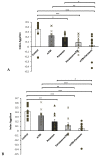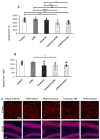Cognitive and Cellular Effects of Combined Organophosphate Toxicity and Mild Traumatic Brain Injury
- PMID: 37239152
- PMCID: PMC10216664
- DOI: 10.3390/biomedicines11051481
Cognitive and Cellular Effects of Combined Organophosphate Toxicity and Mild Traumatic Brain Injury
Abstract
Traumatic brain injury (TBI) is considered the most common neurological disorder among people under the age of 50. In modern combat zones, a combination of TBI and organophosphates (OP) can cause both fatal and long-term effects on the brain. We utilized a mouse closed-head TBI model induced by a weight drop device, along with OP exposure to paraoxon. Spatial and visual memory as well as neuron loss and reactive astrocytosis were measured 30 days after exposure to mild TBI (mTBI) and/or paraoxon. Molecular and cellular changes were assessed in the temporal cortex and hippocampus. Cognitive and behavioral deficits were most pronounced in animals that received a combination of paraoxon exposure and mTBI, suggesting an additive effect of the insults. Neuron survival was reduced in proximity to the injury site after exposure to paraoxon with or without mTBI, whereas in the dentate gyrus hilus, cell survival was only reduced in mice exposed to paraoxon prior to sustaining a mTBI. Neuroinflammation was increased in the dentate gyrus in all groups exposed to mTBI and/or to paraoxon. Astrocyte morphology was significantly changed in mice exposed to paraoxon prior to sustaining an mTBI. These results provide further support for assumptions concerning the effects of OP exposure following the Gulf War. This study reveals additional insights into the potentially additive effects of OP exposure and mTBI, which may result in more severe brain damage on the modern battlefield.
Keywords: cognitive and behavioral tests; mTBI; neuroinflammation; neuronal loss; organophosphates.
Conflict of interest statement
The authors declare no conflict of interest.
Figures




References
-
- Lucke-Wold B.P., Logsdon A.F., Nguyen L., Eltanahay A., Turner R.C., Bonasso P., Knotts C., Moeck A., Maroon J.C., Bailes J.E. Supplements, nutrition, and alternative therapies for the treatment of traumatic brain injury. Nutr. Neurosci. 2018;21:79–91. doi: 10.1080/1028415X.2016.1236174. - DOI - PMC - PubMed
Grants and funding
LinkOut - more resources
Full Text Sources
Miscellaneous

